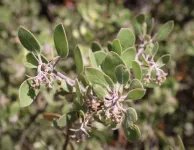(Press-News.org) On May 6, 1954, Roger Bannister pushed through the finishing tape at Iffley Road track in Oxford, England, and collapsed into the arms of friends after becoming the first human to run a mile in less than four minutes.
“It was the running equivalent to summiting Mount Everest for the first time,” said University of Colorado Boulder Integrative Physiology Professor Rodger Kram. “Prior to Bannister, it was considered impossible—beyond the limits of human physiology.”
Seven decades later, a female runner has yet to follow in Bannister’s footsteps, and some have questioned whether it’s possible. A new study published this week by Kram and his colleagues suggests that with the right strategically timed and placed pacers, the answer is yes— and Kenyan Olympian Faith Kipyegon is on the brink of doing it.
“We found that if everything went right, under a couple of different drafting scenarios, she could break the 4-minute barrier,” said co-author Shalaya Kipp, an Olympic middle-distance runner who earned her master’s degree in Kram’s lab. “It’s extremely exciting that we are now talking about, and studying, the limits of female human performance, too.”
From ‘Breaking 2’ to ‘Breaking 4’
In 2016, Kram’s lab calculated what was required for a man to break the fabled two-hour marathon barrier.
He and his students determined that, along with intense training, state-of-the-art shoes and an ideal course and weather conditions, drafting—running behind or in front of another runner to reduce air resistance— was key.
Informed in part by their research, Nike hosted the Breaking2 Project in May 2017 to create those conditions for Kenyan marathoner Eliud Kipchoge. Kipchoge narrowly missed his goal that day but nailed it in a similarly staged race in Vienna in 2019.
Four years later, Kram watched with interest as Kenyan runner Faith Kipyegon crushed records for the women’s 1,500 meter, the 5,000 meter and the mile— all in less than two months, while raising her daughter.
When Kipyegon smashed the mile world record for women with a time of four minutes, 7.64 seconds, she was just over 3% away from breaking the 4-minute-mile, noted Kram. Coincidentally, when his team first started doing their research, the marathon world record holder was about 3% shy of a two-hour marathon.
Kram and his former students, now spread out at research institutions around the world, reconvened—this time to explore the limits of female human performance.
The power of drafting
Run alone, even on a still day, and air molecules bump into you as you move through them, slowing you down. Run in the shadow of a pacer or, better yet, with runners in front and back, and you use less energy.
“The runner in front is literally pushing the air molecules out of the way,” said Kram.
At a four-minute-mile pace, a runner of Kipyegon’s size must overcome a surprisingly large air resistance force—about 2% of her body weight. The team previously determined that completely eliminating that force would reduce the energy required by about 12%, allowing her to run even faster.
“Anyone from top elite to lower-level runners can benefit from adopting the optimal drafting formation for as much of their race as they can,” said Edson Soares da Silva, first author on the new paper.
For instance, da Silva calculated that a 125-pound, 5-foot-7 female runner who typically runs about a 3:35-minute marathon could improve her time by as much as five minutes.
A magic number
For the new study, the team pored over video of Kipyegon’s record 1-mile finish in Monaco.
The conditions were ideal, but her pacers ran too fast at first, said Kram, letting the gap between them and her widen. By the last lap, her pacers had dropped out and she was on her own.
Ideally, he said, one female pacer would be perfectly spaced in front, another in back, for the first half mile; then another fresh-legged pair would step in to take their place at the half-mile point. Collectively, previous research suggests, they could cut air resistance by 76%. Using that value, the team calculated her projected finish time: Remarkably, 3:59.37 — the same time Bannister hit in 1954.
Inspiring scientists and runners
Kipp, now a postdoctoral researcher at the Mayo Clinic, stresses that their study, like many in the field, was based on previous studies that excluded women.
The authors hope that their paper will help spark more interest in studying the physiology of female athletes and inspire interest in female track and field.
They recently sent a copy of the paper to Kipyegon, her coaches and her sponsors at Nike, floating the idea of another staged race, similar to Breaking2.
“Hopefully,” the last line of the paper reads, “Ms. Kipyegon can test our prediction on the track.”
END
Study: First female runner could soon break the 4-minute-mile barrier
With ideal drafting and pacing, Kenyan Faith Kipyegon could soon reach the track and field milestone
2025-02-26
ELSE PRESS RELEASES FROM THIS DATE:
High dietary fish intake may slow disability progression in MS
2025-02-26
A high dietary intake of lean and oily fish may slow the progression of disability in people with multiple sclerosis (MS), suggests a comparative population based study, published online in the Journal of Neurology Neurosurgery & Psychiatry.
The anti-inflammatory and neuroprotective properties of the nutrients found in fish may be key, say the researchers, who add that their findings underscore the potential importance of diet in managing the disease.
Emerging evidence indicates that diet may have a role in the development of inflammatory diseases, including MS, explain the researchers.
While previously published research has linked fish ...
UK Armed Forces servicewomen face unique set of hurdles for abortion access/care
2025-02-26
UK Armed Forces servicewomen needing an abortion face a unique set of hurdles around access and care, as well as stigma and judgemental attitudes from senior (usually male) colleagues, indicates the first study of its kind, published online in the journal BMJ Sexual & Reproductive Health.
Although based on a relatively low response rate, the findings prompt the researchers to call for more information and policy on abortion provision, both for service personnel and military healthcare professionals.
In the UK around 1 in 3 women ...
Use of strong synthetic opioids during surgery linked to poor composite experience of pain
2025-02-26
The use of powerful synthetic opioids, such as sufentanil and remifentanil, during surgery is linked to a subsequent poor ‘pain experience’---a composite of emotional, cognitive, and physical aspects of pain— suggests research published in the open access journal Regional Anesthesia & Pain Medicine.
The findings highlight the need to reassess intraoperative pain relief strategies to reduce complications after surgery and improve the quality of patient care, say the researchers.
Most patients ...
UK innovation to transform treatment for people with type 2 diabetes worldwide
2025-02-26
Millions of people with type 2 diabetes could receive better treatment thanks to a new, simple low-cost tool, according to groundbreaking research announced today at the Diabetes UK Professional Conference 2025 and published in the Lancet.
Researchers at the University of Exeter, funded by the Medical Research Council, Wellcome and NIHR Exeter Biomedical Research Centre, and supported by Diabetes UK, have developed an innovative way of identifying the most effective glucose-lowering drugs for a person with type 2 diabetes. By predicting which drug will lead to the largest reduction in blood glucose ...
AI model can read ECGs to identify female patients at higher risk of heart disease
2025-02-26
Peer reviewed/ Simulation/modelling /People
A new AI model can flag female patients who are at higher risk of heart disease based on an electrocardiogram (ECG).
The researchers say the algorithm, designed specifically for female patients, could enable doctors to identify high-risk women earlier, enabling better treatment and care. Details are published today in Lancet Digital Health.
An ECG records the electrical activity of the heart and is one of the most common medical tests in the world. In ...
Biological organ ages predict disease risk decades in advance
2025-02-26
Our organs age at different rates, and a blood test determining how much they’ve each aged could predict the risk of conditions like lung cancer and heart disease decades later, finds a new study led by University College London (UCL) researchers.
The findings, published in The Lancet Digital Health, show how accelerated ageing in specific organs can predict not only diseases affecting that organ, but diseases across the rest of the body as well.
Lead author Professor Mika Kivimaki (UCL Faculty of Brain Sciences) said: “Our organs function as an integrated system, but they can age at different rates. ...
New manzanita species discovered, already at risk
2025-02-25
A new species of manzanita — a native California shrub famous for its twisted branches and wildfire resilience — has been discovered on the central coast, but its survival is already threatened by urban development that could destroy much of its fragile population.
The discovery is detailed in a new study published in PhytoKeys, where researchers used genetic analysis to confirm the plant as a distinct species. Named Arctostaphylos nipumu to honor the Nipomo Mesa where it was discovered and its indigenous heritage, the species stands out for its shaggy gray bark — ...
Giant ice bulldozers: How ancient glaciers helped life evolve
2025-02-25
New Curtin University research has revealed how massive ancient glaciers acted like giant bulldozers, reshaping Earth’s surface and paving the way for complex life to flourish.
By chemically analysing crystals in ancient rocks, the researchers discovered that as glaciers carved through the landscape, they scraped deep into the Earth’s crust, releasing key minerals that altered ocean chemistry.
This process had a profound impact on our planet’s composition, creating conditions that allowed ...
Toward high electro-optic performance in III-V semiconductors
2025-02-25
(Santa Barbara, Calif.) — From integrated photonics to quantum information science, the ability to control light with electric fields — a phenomenon known as the electro-optic effect — supports vital applications such as light modulation and frequency transduction. These components rely on nonlinear optical materials, in which light waves can be manipulated by applying electric fields.
Conventional nonlinear optical materials such as lithium niobate have large electro-optic response but are ...
In mouse embryos, sister cells commit suicide in unison
2025-02-25
UdeM reproductive biologist Greg FitzHarris and his team show for the first time that sister cells can communicate with each other through a bridge that allows them to die in a coordinated way.
Sister cells are a pair of cells that share the same mother cell. In a new study published in Developmental Cell, researchers led by Université de Montréal (UdeM) professor Greg FitzHarris show how the early mouse embryo gets rid of the defective or unneeded cells in pairs.
“Such a mechanism could serve to ensure the elimination of cells with a ...
LAST 30 PRESS RELEASES:
Review article | Towards a Global Ground-Based Earth Observatory (GGBEO): Leveraging existing systems and networks
Penn and UMich create world’s smallest programmable, autonomous robots
Cleveland researchers launch first major study to address ‘hidden performance killer’ in athletes
To connect across politics, try saying what you oppose
Modulating key interaction prevents virus from entering cells
Project explores barriers to NHS career progression facing international medical graduates
Jeonbuk National University researchers explore the impact of different seasonings on the flavor perception of Doenjang soup
Two Keck Medicine of USC Hospitals named Leapfrog Top Teaching Hospitals
World-first discovery uncovers how glioblastoma tumours dodge chemotherapy, potentially opening the door to new treatments
A fatal mix-up: How certain gut bacteria drive multiple sclerosis
New AI tool identifies not just genetic mutations, but the diseases they may cause
Deep-learning model predicts how fruit flies form, cell by cell
Combination pills for high blood pressure may simplify treatment, improve long-term health
Immune system keeps mucosal fungi in check
Neurons within the brain use simple rules to localize genetic messages
Electrodes created using light
Second-hand gift-giving is a well-deliberated decision
How human interaction drove evolution to make bears less aggressive
National Poll: Few parents offer teens guidance on healthy eating during holiday season
Cannabis derivatives could provide new ovarian cancer treatments
Raising strong yeast as a petroleum substitute
Clues to the origin of hot Jupiters hidden in their orbits
Canada’s reduced pledge to Global Fund will impact domestic health
1 in 4 children with major traumatic injuries not cared for in pediatric trauma centres
Duke and Duke-NUS’ joint cross-population research to uncover "East-West" differences in disease and care
Scientists to ‘spy’ on cancer- immune cell interactions using quantum technology breakthrough
Tech savvy users have most digital concerns
Making lighter work of calculating fluid and heat flow
Normalizing blood sugar can halve heart attack risk
Lowering blood sugar cuts heart attack risk in people with prediabetes
[Press-News.org] Study: First female runner could soon break the 4-minute-mile barrierWith ideal drafting and pacing, Kenyan Faith Kipyegon could soon reach the track and field milestone


